Great Expectations
We open in Whitehall, in the increasingly familiar wood screened surroundings of Cromwell’s clerical corner. Where Holbein, having apparently been summoned, looks out of his element and is waiting and pacing a bit. The talk around him is all business and politics.

Then Cromwell, the centre of this little universe, marches in and walks straight up to Holbein as his civil servants make sure to look busy. He’s here to talk about the painting of Anne of Cleves Henry commissioned last episode. Holbein is surprised, and has apparently been listening in on all the political talk going on around him – gesturing with his arm and saying to Cromwell “So many pressing things, and yet you have time to talk about a painting.”
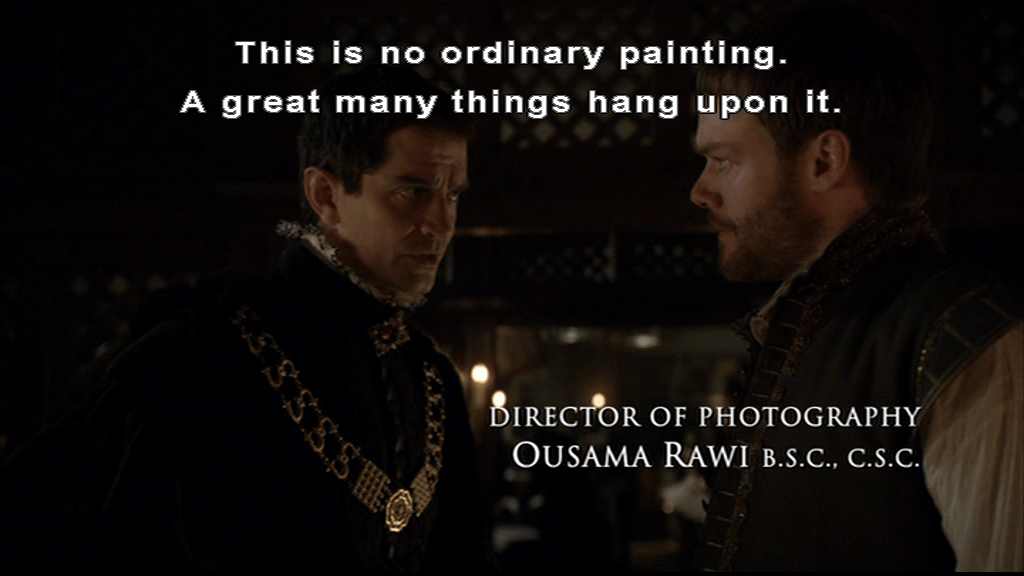
Cromwell is very Intense Cromwell today. He is sees and is focused on his salvation in this plan to marry Henry to Anne of Cleves, so he wants the truth massaged, if necessary. It was Cromwell that was central to the Cleves negociations, trying at the beginning to get Cleves to offer her up, instead of England having to request her:
“…not as demaunding her, but as giving them a prick to storr them to offre her, as the noblest and highest honour that could come into the noble house of Cleves, if they could bring it to passe”(q)
It was Cromwell choosing the envoys and giving them instruction. he doggedly pursued the Cleves alliance until it was an idea whose time had come. (q)

He wants that truth loose and limber and energized and ready for its day ahead so pop the truth on the table, oil paint up and get rubbing, art guy.

And that’s not a far sighted view from Cromwell. Other kings might have made marriages with women that were not the goddesses of their imagination because their country or their family needed it or it would help their throne, but Henry had never been required to develop that kind of discipline. He had always married for desire, and so far, to get to that kind of desire, he had to know the lady first, whether she had been his older brother’s wife, or a lady in waiting to his current one.
Of course another pattern in there was that whenever Henry and future wife #tbd met, the lady had always been quite ‘forbidden’ to him as well (Older brother’s wife, lady in waiting to his current wife x2) and Cromwell was really desperate to serve him Anne of Cleves on a plate of inevitability.
Crisis Meeting
We sweep into a very tense Privy Council meeting with Tom Seymour, just a little bit late.
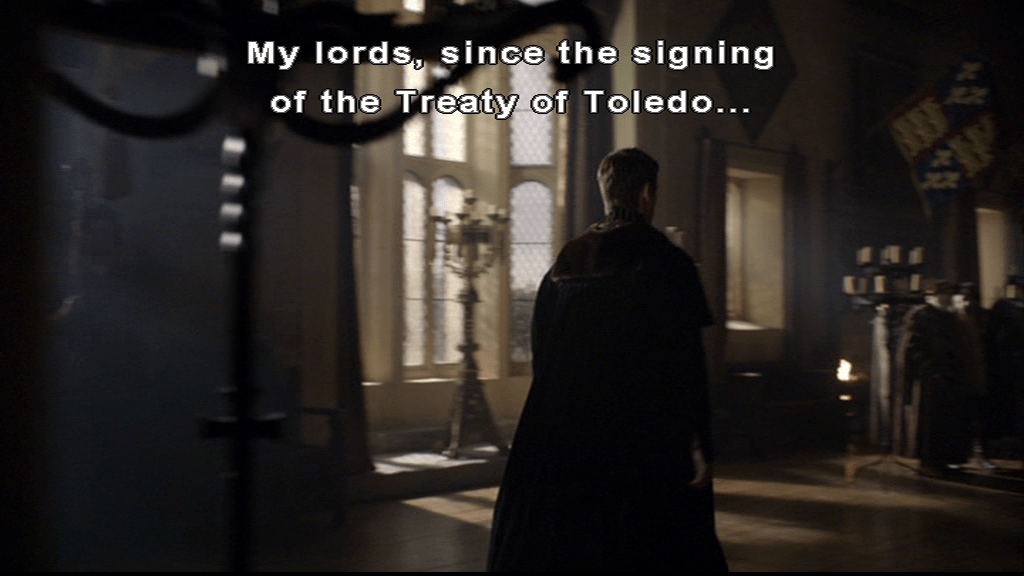
International politics took quite a turn in early 1539. There had been a lot of treaties, pacts and agreements between the Imperials and the French during 1538, and it’s pretty clear with the hindsight of history that these were the result of Charles HRE trying to free his hands to fight the Ottoman Empire.
Splitting the Ottomans off from their Western European ally, France was the main goal, but the Treaty of Toledo, in January 1539 was where Charles and Francis started boxing in the English. It was basically an agreement that neither Francis nor Charles would enter into any alliance with England, and the stalled negotiations for Henry’s potential marriages were stopped.
In the Main Hall, Cromwell gives a rundown of the evidence of the threat they face, to a meeting that actually includes Henry.

The English stopped shipping from leaving their ports (1), but the Imperials had also been doing that, in their case because they wanted the sailors for a potential invasion of the Ottoman Empire, which was what Charles was doing all this for(2). All the main Ambassadors: Chapuys, Castillion, Wyatt and Wriothesley got recalled, Chapuys finding it difficult to cross the channel with all the usual traffic stopped, and Queen Mary, Regent of the Netherlands doing everything she could, including perhaps a teensy bit of house arrest, to delay Wriothesley’s leaving until she had heard that Chapuys had landed at Calais.(2)
It was tense, early 1539. And into this situation dropped rumours and conjecture, some wild, like the one about 30,000 troops being prepared to be sent to Scotland (3), and some more scarily believable, that it was just 3,000 Imperial troops but they were already there (4).
In The Tudors Cromwell gives an efficient summary of all this, but the highlight of this bit might be the super tense handovers between him and Charles Brandon, who is being very the Duke of Norfolk right now. Cromwell got to tell everyone how scary the situation is and Brandon gets the far better job of telling everyone what the plan is for the scary situation.
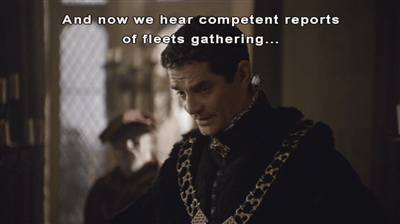
The most historically significant of these are probably those forts he mentioned. Device Forts (From the detailed plan or ‘device’ put through Parliament ordering their building) would become familiar sights on the Southern coast of England. Like any programme of public works some failed and a fair amount of money was wasted, but others proved incredibly useful and survived, seeing service as military defences for every major conflict first England, and then Britain entered into for the next five centuries, because in a few cases they were in use by the military up to and including WWII.

The last to be decommissioned from military use was Calshot Castle in 1961. They remain one of Henry’s longer lasting legacies.
Back in the room, Henry’s blaming the hell out of the Pope.

He was right, though. All the momentum for an English invasion before the Emperor sailed off to Turkey was coming from the Pope. Perhaps this Henry has heard about the very special visitor the Pope sent to the conference at Toledo, who arrived just after the treaty was signed.

Henry stands up, a little cronky these days, leaning forward and putting his weight on his stick, and announces a series of visits to the defensive locations.

Charles gets a literal pat on the back, he did well today, and the meeting breaks.
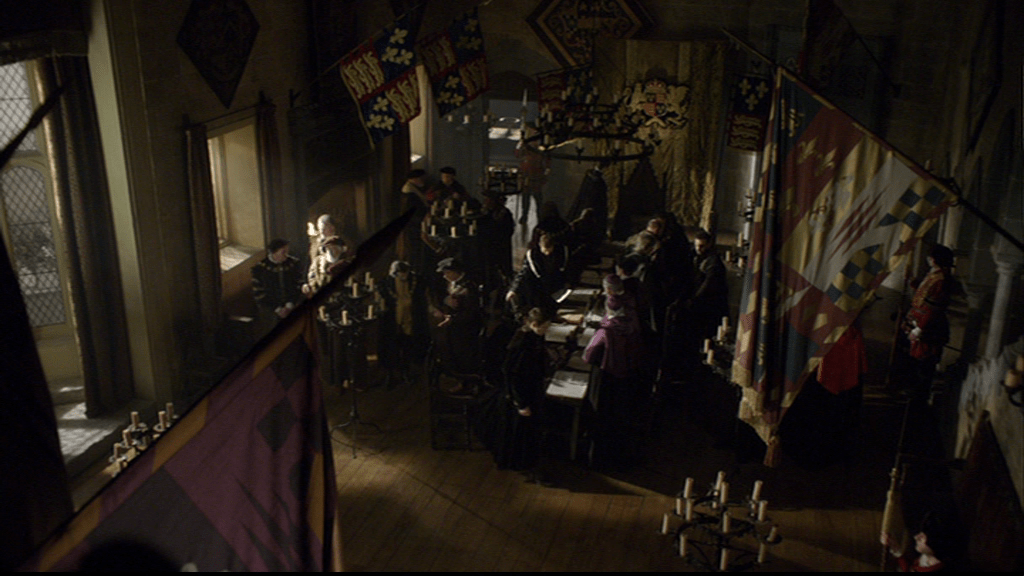
There are two sub meetings of interest as everyone leaves, first Tom Seymour and Francis Bryan. And by this point I’m almost contractually obligated to tell you that this line used by Tom to describe the English situation right now…

is an Actual Historical line from Wriothesley, who was trapped, at the time, by Queen Mary in the Netherlands (5). Sir Francis shares the news that Cardinal Pole is on a secret mission for the Pope, and that they’ll be after him again once they find out where he is.
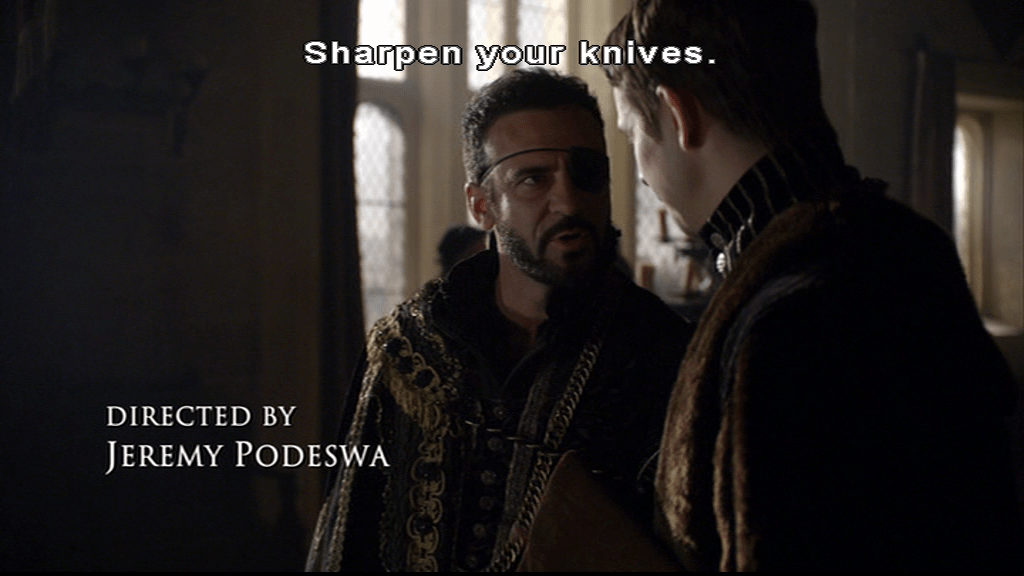
Across the room, Tom’s older brother tries to get a meeting with Brandon, and is rebuffed. Charles is far too busy with manly defence stuff, right now, and you can tell Edward is both very successful and a bit intimidating to members of the court in general now because he is very dissapointannoyed at Brandon leaving him on ‘read’.

Time Skips and Failed Ships
We have a chunky time jump. Holbein has been to Germany, and has had time to work up a miniature, all of which actually historically takes us fair bit into the summer of 1539. The miniature is the painting Henry would have that drew his interest at the time, and The Tudors does a reasonable job of combining the known painting with their version.
Holbein would finish the full painting later.
So did the painting lie? The reasonable route to go down to answer this question is to compare this and Holbein’s big portrait (now at The Louvre – Henry didn’t hang on to this one) to the contemporary reports and another contemporary painting of her, by Bartholomaeus Bruyn and currently held by St. John’s College, Oxford.
So, that outfit is amazing and she seemed to favour warm colours and either Holbein was lying about the belt and bust lines or Anne was pretty slender. Also, while the general consensus has been ‘tall and big boned’ Ambassador Marillac at the time called her ‘Tall and thin'(10) . Whatever her BMI she seems to have been tall. I’m ready to believe she had chunky hands.
There have been x-rays of the Holbein which indicate there was originally a longer nose, (6) and it’s been noted that the full face pose would naturally minimize nose length anyway, so yeah, maybe Holbein worked around that a bit. But Holbein was known for being the guy for a likeness, he was sent to paint Anne and her sister Amelia (Amelia’s portrait doesn’t appear to have survived) and Wootton, one the English envoys who had seen both the sisters and their portraits said Holbein got the likenesses very well.(7)
Cromwell then goes in with some actual historical hyperbole, saying that:
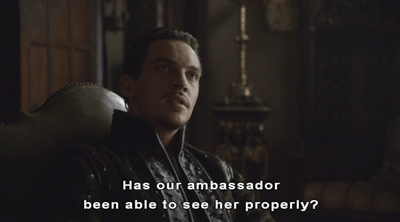
Yeah…that’s not quite what he said. The report was from Christopher Mont, not Sir John Hutton, but economy of characters and everything. And Christopher Mont had reported the Golden Sun/Silver Moon statement, but reported it was said by ‘someone in the court’, not him.(8)
Also Cromwell in his Actual Historical report to Henry left out other parts of the report he got from Christopher Mont.
“Every man praiseth the good virtues and honesty with shamefastness”(or modesty)”which appeareth plainly in the gravity of her face.”(9)
And, taken on its own that’s fine but Antonia Fraser paired it up with a guy with no strong stake in this, the new French Ambassador Marillac’s assessment of her in which he described her as:
“…of middling beauty, with a determined and resolute countenance” and that there was “a steadiness of purpose in her face to counteract her want of beauty”(10).
Marillac also said he thought she was about thirty when she was only twenty four so that ‘gravity’ might well have made her look older (or Marillac was feeling bitchy that day). All of which adds up to the Anne of Cleves heading to England in Autumn 1539 looking reasonably good, but only reasonably good, and also damn solemn. Henry’s subsequent choice of wife will tell you that he was in no way interested in solemn at this point in his life. And the main difference that strikes me between the Holbeins and the Bruyn portrait, is that the Annes in Holbein’s portraits look receptive in a way the Anne in the Bruyn portrait does not. They might be about to laugh at a witty joke you told or dissolve into a maidenly blush. The woman in the Bruyn portrait is not about to do that. She’s distant, and contemplating.
The scene ends with Cromwell, poised at the foot of Henry’s chair, reiterating the proofs not just of the good now but increasingly the need for the Cleves marriage.

Brighton Calls for Aid!
We are outside and on the coast where a lookout spots an hell of a lot of shipping.
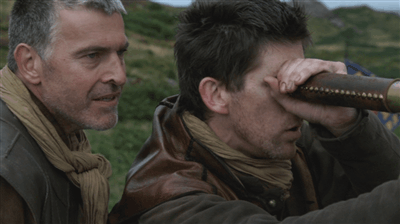
And we are getting very close to Armada territory (If we’re lighting beacons, shit is getting pretty damn real).
A Cygnificant Dukedom
We are back in Swan Castle, Kleve. The current Ducal capital of Cleves was Dusseldorf, a pretty big city and recently brought into the duchy by Anne’s mother. She was the heir of two neighbouring duchies, Julich and Berg, but under Salic law, as a woman she couldn’t inherit them. Her marriage to Anne’s father, and her son William’s subsequent succession to all the territories had given Cleves its current boost on the international scene.
It was a Dukedom, and inside the Holy Roman Empire, but it was now near the size of a small country, it controlled the Lower Rhine, and had the trading and military importance all that implied. It was a state within the Empire superstate, but one that could negotiate its own marriages, and had perhaps, not been getting the Imperial attention its increased size and status would seem to recommend recently.
And why yes they would like to talk to the King of England and his renowned minister Cromwell about the future of the lady Anne of Cleves.


Where The Tudors’ Duke William of Cleves is about to become a very hard negotiator, probably ahistorically. Cromwell did send his old friend Stephen Vaughan to bring the negotiations to a conclusion at this point, but that probably had more to do with a positive reaction to the miniature from Henry than Clevian backpedaling(11).
In The Tudors the English negotiators want to bring things to a conclusion but get knocked back by Duke William.

Duke William (Paul Ronan) has apparently been reading the international news, noticed how the political weather has changed, and decides to bring up the fact that Anne was engaged to someone else.
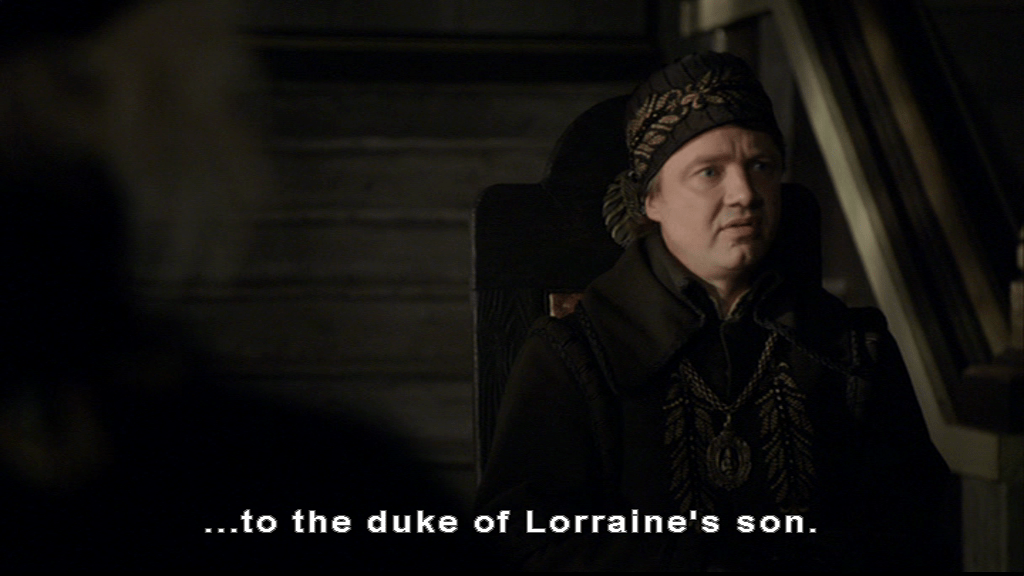
How much of a problem Anne’s previous engagement was rose and fell according to whether Henry was currently wanting to be married to her or not. Unlike Henry’s previous Anne’s previous engagement, this Anne had never even met the future Duke of Lorraine, and as they had been formally engaged before they reached the age of consent it wasn’t considered legally binding. If Mary I had had to marry every man she’d been engaged to before the age of consent she would have had about 15 husbands.
No one saw it as a serious problem at this point, and there’s no indication the Clevians started stalling or re-negotiating the terms. But that’s exactly what The Tudors’ Duke William does. The English envoys start getting indignant, bit William has some powerful indignation of his own.
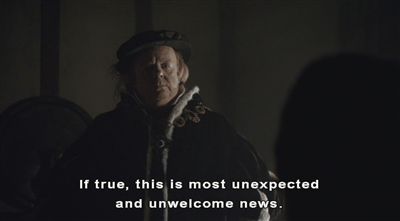
The News Moves
Meanwhile, in Whitehall, some news is damn near flying in to meet Henry.

The news that’s moving is a letter from Thomas Cheyney, Lord Warden of the Cinque Ports, containing all the info about that fleet we beaconed up for last time we were outside. And, while I’m ready to be wrong, (sometimes things do come up later) I haven’t found it or anything much like it in the historical record. Still, running into the Emperor’s supply fleet for his actual invasion is a neat way to resolve the tension from the first part of the episode, and reveal what’s actually been going on.

And Henry seems to be in between relief and deep irritation as he realizes what has happened – that the sword in the dark was a butter knife after all, and it’s all a bit embarrassing. I rather like Cromwell’s “Are we sure it’s not a deadly threat?” reaction moments.

Also Henry’s really starting to work the Protestant ‘restrained opulence in black’ style, even if Season 3’s other style note for men, the big furry shoulders are never going to work on him.
Personality Politics
The importance of charm in diplomacy can sometimes be overlooked, but the series long relationship between Antony Brophy’s Chapuys and JRM’s Henry in The Tudors is a nice demonstration of it. Good diplomacy can minimize the fallout of some of your power’s actions and if any other ambassador had sauntered through this door to tell Henry how the trick was done I think they might be running out. But Henry’s reactions to the Empire have to go through this filter of a guy he personally likes and respects.

Henry gives us a nice summation, but this scene is here to explain the politics, and provide Henry with a bit more impulsion on the very smooth road to marriage with Anne of Cleves. Actually Historically Chapuys took some time out to sort out his domestic affairs this recall (He was getting quite rich, and had an illegitimate son to provide for) and was away for about a year, coming back to his English mission in 1540, and consequently for about a year the Spanish Calendar of State Papers gets as dull as shit.
The liberties with the timeline don’t end there in this scene. Chapuys, while explaining that the Ottoman Empire was where Charles was heading the whole time, implies the Imperial-French agreements have already broken down. They might have been breaking down at the top level, but it would take nearly 3 years for war to break out between them again, in 1542.
Chapuys explains that the Franco-Ottoman alliance is just too threatening for Charles with his territories so close to the increasing reach of the Ottomans.


But hey, there was an Actual Historical brief attempted resurrection of the Christina of Milan Plan just as the Cleves negotiations were concluding. At this point, the English Court decided it was somewhat encouraged by Charles V’s mounting discomfort at one of his largest German territories suddenly being allied to England and Henry(12), and it did nothing to slow the momentum to union with Cleves.
Chapuys’ predecessor Mendoza would have been screamed at, but it’s a somewhat more restrained moment with Chapuys and Henry. Henry giving Chapuys a kissing distance ‘most disappointed with you’ face, as he explains that he wasn’t delighted at being cast in the role of a distraction for the French and the Pope, and God yes he is going to take this personally.
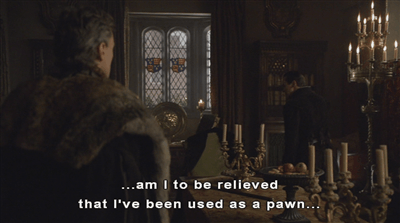
Henry then picks up an apple, takes an angry and desultory bite before throwing it against a very sturdy sideboard.
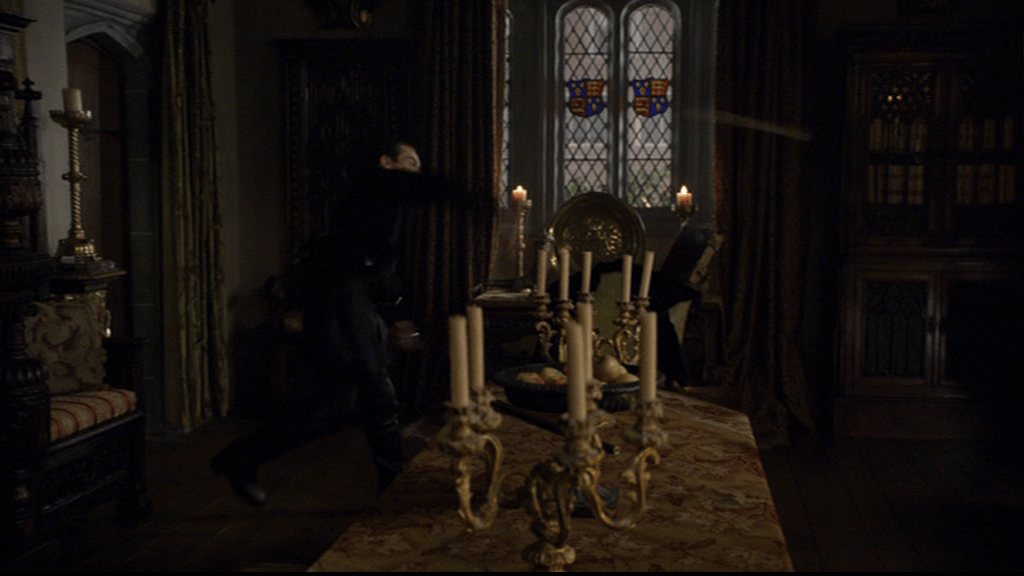
Oversold
Maybe he’s angry because of the instructions he’s given to his ambassadors at Kleve in the meantime, which are the instructions he actually gave at the next round of negotiations, when the Clevians came to London and the marriage treaty got signed on October 4th. (13)
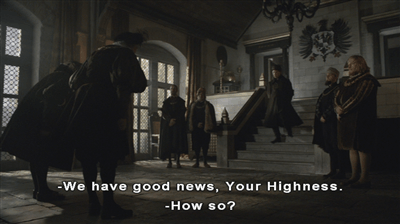
In the old patriarchy, a dowry was kind of required. The excuse Henry is given for refusing it is that he ‘knew William would not be able to afford it’ and that sounds a bit generous to me. Not being able to afford a dowry didn’t stop others from demanding them. His father kept Katherine of Aragon in the country for years on the grounds that hers hadn’t been paid. Henry had entered into the international marriage game twice and came out, both times, dowryless, which most other men thought was basic point of international marriage negotiation. Dowries had and would save ambitions and houses and estates and even kingdoms, but Henry was rich right now and Henry was terrible at this. Two international level brides, not one dowry for Henry (q2).
Anne’s pre-contract to the future Duke of Lorraine comes up,
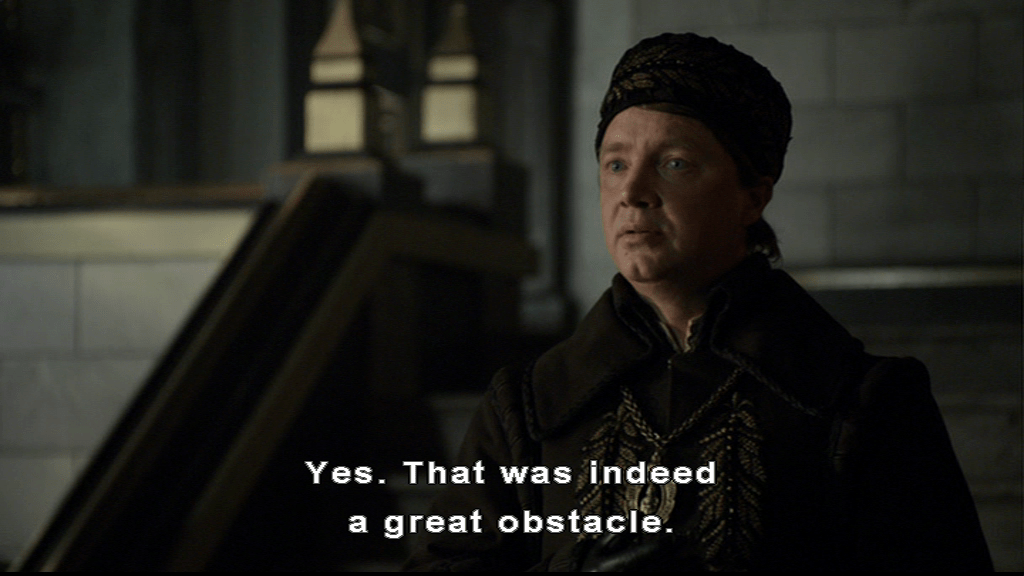
and wouldn’t you know they’ve had a look at it and it wasn’t binding after all.

And with Duke William trying not to run out of the room with the deal he just got, and the two English envoys delighted to have completed the business we leave Kleve with everyone briefly happy.
Sir Francis Bryan’s International Intrigue Workshop
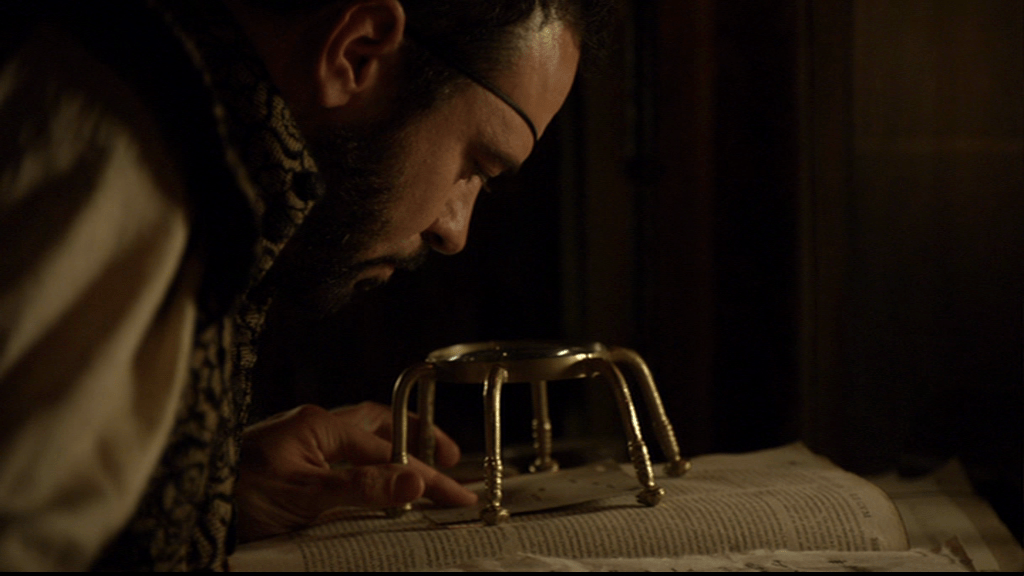
In a pleasant window seat, in a quiet corner of Whitehall, Sir Francis Bryan is using those coding skills he’s so proud of, and decoding a letter of Cardinal Pole’s that Cromwell’s guys have intercepted.

As well as nice slice of what Francis and the younger and more reckless Seymour brother are currently up to, this scene also catches us up with Cardinal Pole. Pope Paul had sent him to Toledo, to request on the Pope’s behalf the invasion of England by the Emperor, before he tried to invade the Ottoman Empire. To which Charles HRE basically replied “I’m about to attack an actual Muslim Empire, right now. The King of France only just left his heathen allies, isn’t doing anything but gaining strength at the moment and he’s also really deep allies with Scotland so how about you ask him if that’s a thing you wanted done Your Holiness?”.
Francis caught wind of this and had his response to the Papacy and Cardinal Pole ready, and in writing so there was no need for Pole to visit. He would do exactly the same as the Emperor was going to do for the invasion of England (14).

Intriguing
Meanwhile, older brother Edward gets a visit he’s rather been hoping for.

I like Edwards: “The Hell do you care?” expression when Brandon congratulates him on becoming Earl of Hertford. But we care and shall review.
King>Prince>Duke>Marquis>Earl>Viscount>Baron
He was at Viscount last time we looked so Edward “I’ve got a surviving nephew” Seymour is moving on up despite his sister’s death. Still, a new Queen on the scene is a hard time for the old Queen’s family, so he’s been looking for an ally. He is very relieved when that is exactly what former rebuffer, (and guy powerful enough to not give a damn about you until he decides to) Brandon proposes to be.
The enemy they are joining together to bring down is Cromwell, and both characters have been set up to become his enemies. Actually Historically a conversation like this,

would be far more likely to happen between the Duke of Norfolk and Bishop Gardiner than these two who ranged from neutral to positively allied to Cromwell. But while we’re here, in a cozy room, congratulating ourselves and forging new alliances,
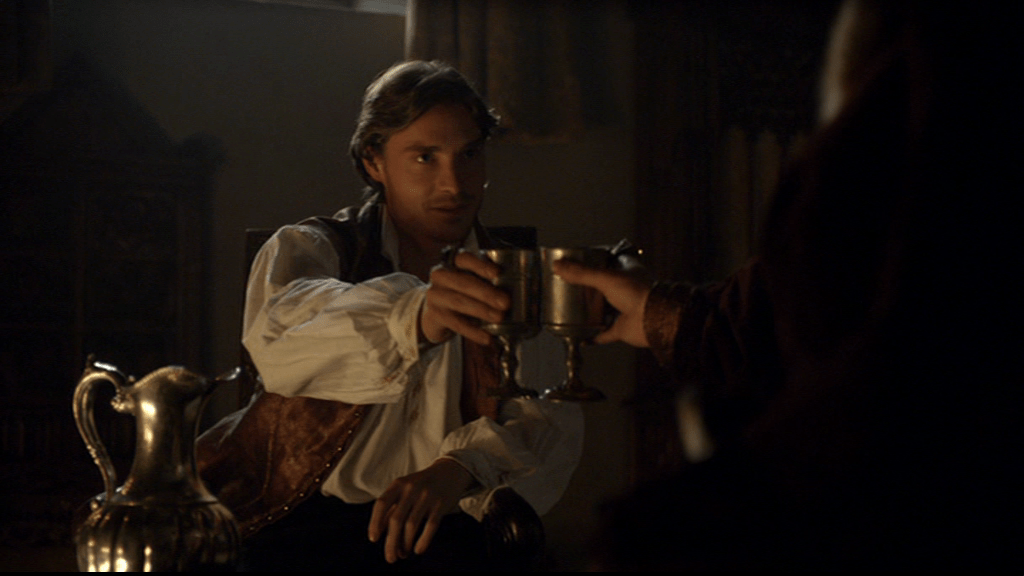
it’s worth mentioning that around this time, as the Cleves negotiations were drawing to a successful close but before Anne set off for England, is somewhere between possibly and probably when a 16 year old Katherine Howard first caught the eye of Henry VIII.
Anne of Cleves was going to need a household, and while a Queen normally chose her own ladies, Anne wasn’t in the country and could not. Henry was apparently quite involved in the process, telling Lady Lisle that he would not allow any lady to serve that “was not meet for the room” (15) so, he met them, right? A lot of the ladies transferred from Queen Jane’s to Future Queen Anne’s service, but top of the list of the new maidens was young Katherine Howard (16), further down were some of the Duke of Norfolk’s other nieces. And about 2 years from now, as the whole affair rushed towards its bloodthirsty conclusion, the Duchess of Norfolk would be interrogated, and asked:
‘Who told her “that the King’s highness did cast a fantasy to Katherine Howard the first time that ever His Grace saw her”?'(17)
There’s a pretty good chance that whatever first moments Katherine Howard and Henry had happened at this point. And maybe the nervous system of the Court quivered with the intriguing news that the King might have a passion again. If Cromwell heard it would have been horrifying, any English bride would have been unwelcome, but the niece of his arch enemy? With the Cleves negotiations concluded, he might just have ploughed ahead anyway.
Then again, Henry was a master of romantic hindsight, and ‘See woman I like, be denied that woman and then make acquiring that woman the centre of my universe, and damn all the consequences’ was not, like, a psychologically unknown state for Henry VIII.
Still, whenever his interest arose, their very first meeting was probably around now, with a 16 year old’s job application to work for Henry’s shortly to arrive wife.
Lovely.
Was she, though?
Meanwhile, in Hunsdon, Mary is team drama right now.
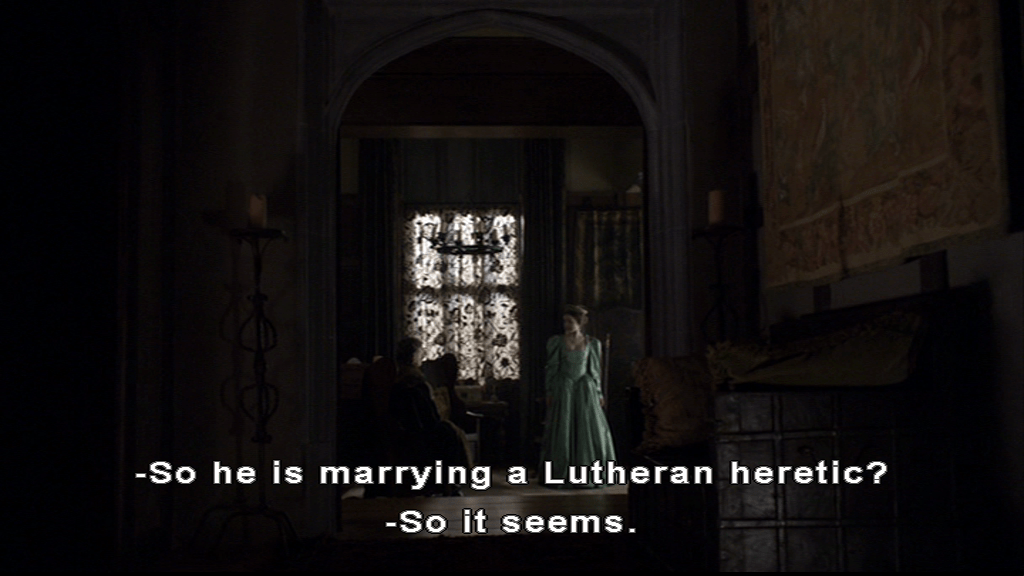
She’s pacing and worrying and Chapuys gradually becomes less of a confidante and more of an increasing hysteria sounding board. She’s momentarily disappointed that she won’t marry but before Chapuys can complete a phrase she’s already recoiled in horror at the very idea of marrying the Duke’s brother,
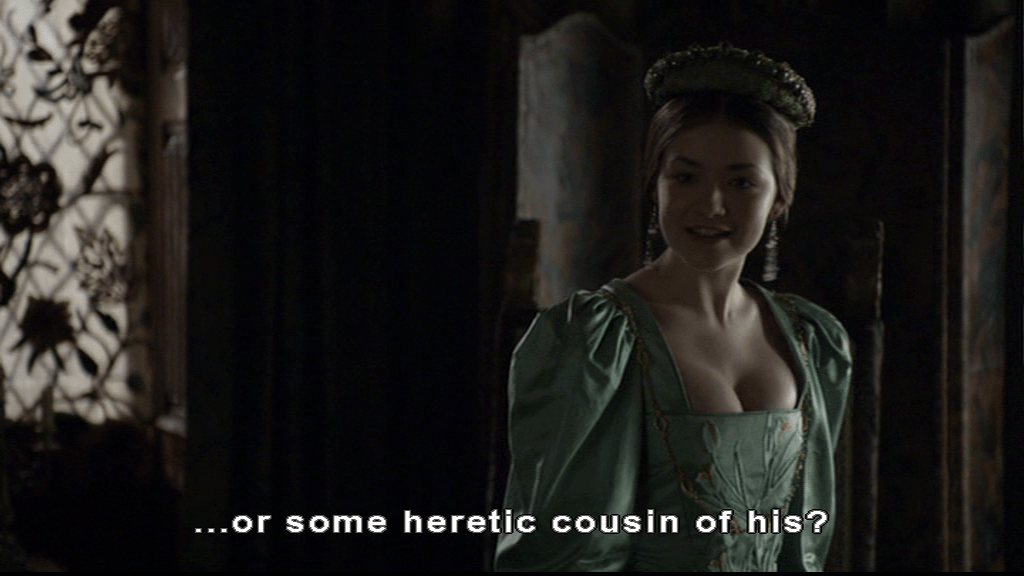
Mainly Mary just cannot make sense of the King’s behaviour.
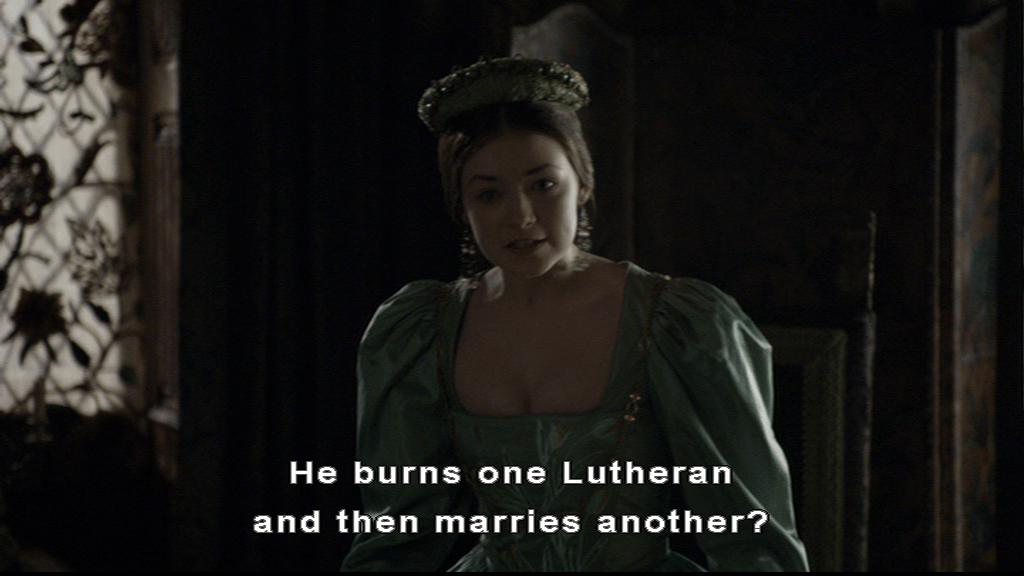
And Mary really shouldn’t have worried. She and Anne of Cleves would get on really well. Because Anne of Cleves wasn’t a Lutheran. In fact Actually Historically, Protestant Anne of Cleves wasn’t a Protestant.
A lot of the German territories were Protestant, but not all of them. And Cleves wasn’t Protestant(18). They did not have a set religion but were mainly unaffiliated Catholics with an emphasis on the works of Erasmus. Her father’s and his court’s great religious influence was Erasmus, not Luther, and Anne’s mother , who supervised her education, was an old school Catholic. Her brother would eventually get Lutheran tutors for his children once Lutheranism had spread through the territory but at the time when Anne married the religion of Cleves, and of Anne’s family could best be described as a Erasman Catholic. Anne’s father Duke John might have married one of his daughters to a member of the Protestant league, but he never joined it.
In short they seemed to practice something that looked a lot (but possibly a bit more Catholic) like the official religion of England, and in her life Anne would both convert to to Anglicanism for her marriage, then to Catholicism when Mary required it. If she’d lived long enough she’d probably have converted religion for Elizabeth, too. So the firebrand Protestant Mary and maybe others were anticipating was not the woman that was on her way.

Mary’s distress causes her to get a bit aggressive, hoping that Anne of Cleves drowns at sea to Chapuys’ ‘worried dad’ face. And as we leave Mary, clutching her forehead and possibly hyperventilating a little after wishing an innocent woman dead (she really is her father’s daughter at times) we are taken right to the vicious storm that stopped Anne of Cleves at Calais from the 11th to the 27th of December 1539 (19).
Oh, Those Calais Evenings

Actually Historically there were no distressed or surprised reactions from the large group of English representatives at Anne’s appearance at the time. That all started after Henry’s disastrous meeting with her at Rochford. At the time, what came out of Queen Anne’s stay at Calais was coloured by the interests of the people who reported on it. From young Gregory Cromwell to Lady Lisle the news was – She’s polite, seems quite kind and it looks like she’s going to be easy to serve. Anne was potentially a huge employer, and most of the people sent to meet her were prospective employees, or relatives of her prospective employees. So, that was the headline in the letters home.
In The Tudors Brandon has been sent to Calais, and we have some brief, near obligatory, polite Anglo-German awkwardness with (Actual Historical members of the Cleves party) Hoghesten and Olisleger.

I mean, if they were Spanish we’d probably be disagreeing over a principle we’d just discovered we had, if they were French we could just go straight to either bitching or fighting, but what does one do in reaction to a 16th Century German? Polite awkwardness from wall to wall it is, but thank god for Count Olisleger’s attempt at humour, making everything a fraction less awkward for a minute there.
The Tudors is going to leave you in absolutely no doubt that its Anne of Cleves looks pretty damn great. We start with her entrance, after her ladies (whose hat choices have made everything a bit awkward again) and she’s still fully veiled.

And she makes a barnstorming impression on Charles Brandon. The lightning gives the Duke flashes of the clearly very pretty woman behind the veil, as she asks, in adorably broken English, some questions, the second of which sends Charles’ mind straight to some light innuendo.
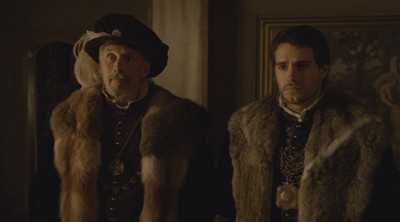
Well, there’s no better way to seduce a proper English noble and Charles is thoroughly charmed. He teaches her to play Piquet, which the card game she was actually historically taught to play (well, Cent, which later became known as Piquet) at Calais by the Earl of Southampton (19). And she’s so well in with Brandon he starts to offer up some ‘real talk’ at the end of their game.

How hot is our Anne of Cleves? So hot she has already won over the handsomest guy at the court, but sadly that’s not the guy she’s being aimed at.
To Carpentras
Because sometimes it has to be all about the journey. We are in the ancient diocese of Carpentras, sidling in a side entrance to a brothel with Francis Bryan and Thomas Seymour. The soundtrack is rhythmic and winding and helped along by a lot of coitus noises, and Bryan and Seymour are desperate to find out what Cardinal Pole is up to.

Francis and Tom actually get their knives out before they realize that’s not Cardinal Pole. The prostitute shrieks, and the Cardinal, who can surely go another ten minutes now, gallantly gives them a blessing.

Francis decides he’s going to make it about the journey and likes the look of the madam, while we close out the scene to the same sinuous soundtrack, but this time over a montage of Reginald Pole at his devotions.
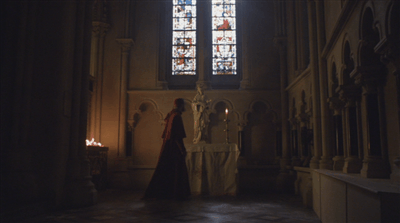
And I think this is the last we see of Mark Hildreth‘s Cardinal Pole. In Actual History he would be back, big time, to enthusiastically serve as the last ever Catholic Archbishop of Canterbury in the Marian Regime.
Fashion Week, Again?
God, I hope not, Henry looks like a Christmas present this morning.

He and Brandon start by discussing the state of the Cardinal pole assassination plan, providing a link to the previous scene.
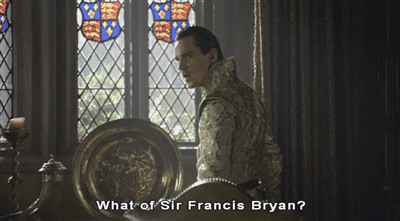
He’s nervous, he’s pacing, he’s asking questions, Henry is unsure. He’s even down to the deeply personal questions men tried very hard to avoid asking before reliable practical help with the problem became available. And while we probably have to acknowledge that any 16th Century guy would fail this, and especially one coming from the perspective of already seriously liking Anne of Cleves, it has to be said that Brandon utterly tanks the delicate ‘ Lets be friends talking frankly about possible male impotence issues’ test.

The plan was never for them to meet at Rochford, but Henry’s patience snapped, and he rode out early to meet her on New Year’s Day (20). He ends the scene staring intently at the miniature portrait, perhaps trying to identify what it is he wants to see.

To Rochford

Henry gets a good gallop in, and almost looks optimistic as he pulls up to the castle Anne is staying in. And here there’s a deviation from the historical record. While Henry does tell his messenger that a ‘gentleman’ is here with a new year’s gift, Anne is aware of who he is from the moment he walks in the room.

Actually historically, she was watching a bull baiting, and had no idea who the strange man offering her gifts was, and gave the impression of being a bit bored, and seeing no need to interrupt what she was doing (20). He was in disguise and she was supposed to recognize the true love in this chapter of the courtly love drama, and she didn’t.
In The Tudors he is disappointed the moment he sees her, and is so disappointed he pantomimes his disbelief to the messenger, that this, this, is the woman that has been brought to him.
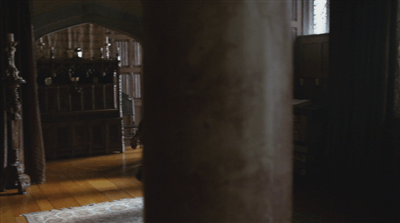
The Tudors gets the shambloic nature of the meeting right, she both can barely understand him and is poleaxed by his very negative reaction. He tries a kiss, that she is clearly in no way ready for.
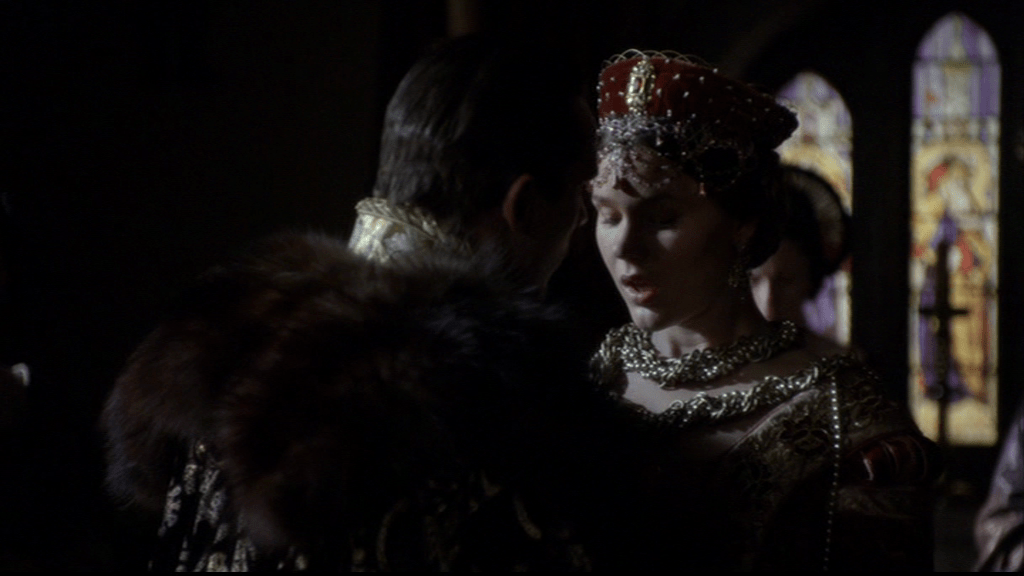
Kissing on the lips used to be a standard formal greeting to an English noble woman, but Henry should (and possibly would) never have expected a Continental bride to be down with that. Pretty much every visiting foreign gentleman wrote back home “Hey, some great customs here. You kiss them right on the lips. To say hello!”, so yes a high born German woman would have been very surprised by that. There’s nothing in the record to indicate Henry was quite that gauche.
The conversation stutters to a halt, and Henry excuses himself, grabbing the furs he brought as a present on the way out. So boy, did it go badly.
Anne rushes to blame herself. She didn’t train well enough, everything is so different here.

And there’s something to that cultural difference, but we’ll get into it next week, as the days tick by and they keep failing to click.
Today, the court is boisterous and noisy. Cromwell is in the middle of his victory, laughing with Sir John Hutton when Henry very unexpectedly strides in to crash the party in every way.
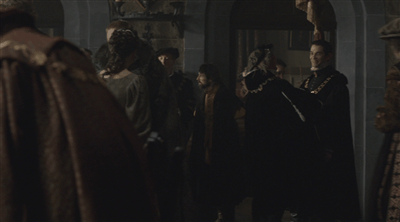

Edit: A light edit, linked up the footnotes. Got a bit less Marillac about some stuff. 17/10/2020
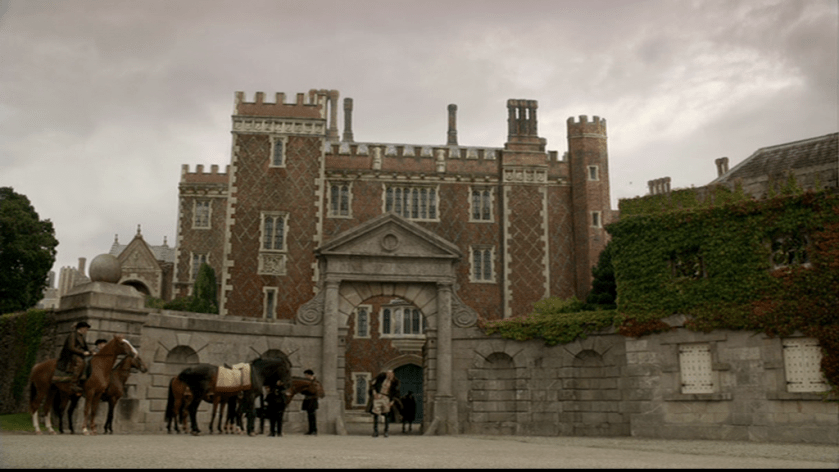

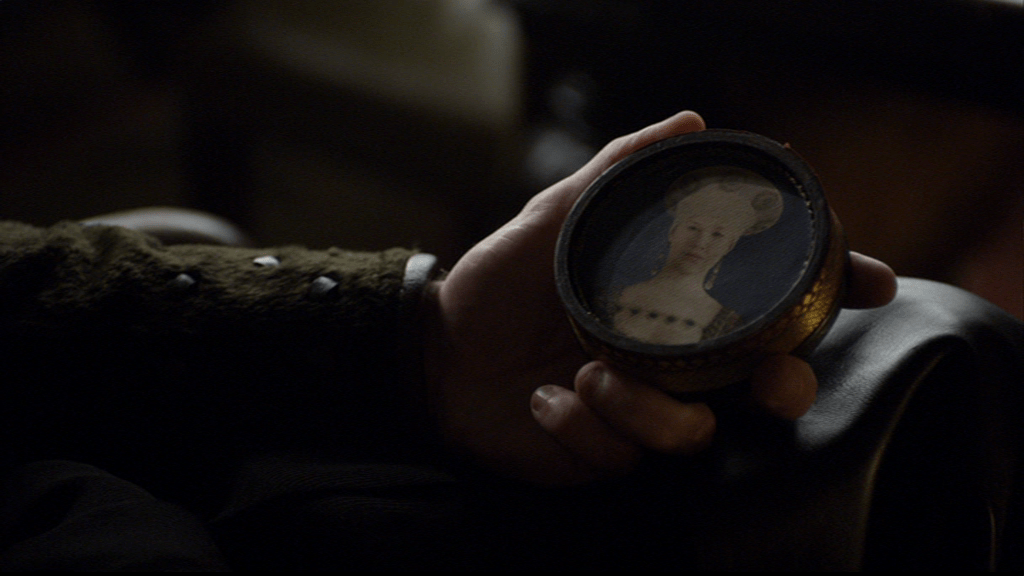


How often are you posting ? I love reading your reviews and want to hear the rest of this series!
LikeLiked by 2 people
I love reading your reviews/recaps! I just finished the series but still check back here to see if your reviews go past episode 7 season 3 …will you be continuing??
LikeLiked by 2 people
Hello there, and yes, I am indeed. Just completed a new one. Thanks for the support, and I’m planning on having the next recap done by the end of the month.
LikeLiked by 1 person
Okay did anyone notice that Mary’s outfit was so so not Mary like? I mean maybe Sarah bolgers (sp?) dresser was out sick or the Lady Mary has decided to wear brighter colors like the sea green/blue gown and seems to wear a hat style I do not recall ever seeing in her (maybe it’s to be more Cleves like so Anne and gang don’t look so different…didn’t work it just made Mary stick out). So I have always had compassion for the lady Mary but is she going to get all nasty and wishing for deaths, perhaps letting her later daddy like authoritarian style showing up here and there, when wearing lighter and brighter colors with foofy sleeves and caps? (Brought to mind Napoleon saying ‘uh I really like your sleeves’- different sleeve but still caught my eye the same way) She has appeared in rather somber gowns at times (and no wonder given what she’s been put through) to some truly beautiful ones but they are always darker and regal as she gets older. Maybe her dress for her later murdery side will come out in spring pastels in silks and light taffetas? So Mary in bright gowns = petulant, snide, mean girl side? I know that she did not have the reputation at this time for her later callous behavior (I know, I know, she’s not bad compared to….fill in the blank…but still burning that many people and um illegally with Cranmer…I just think it was not a good way to show people her love of god and the catholic faith by getting all burny. I mean for anyone. Just for her I wonder will she do it in spring pastels? Hmmm. I think maybe it’s more likely that someone was out sick and later on they were like ‘you dumb@%#*’ can’t I even have one day off?!’ Shes supposed be showing her psycho side, being death wishy and all (bc yes it’s very god like to wish some poor woman that’s used as currency to drown) and lady Mary is too serieux to wear that line! And smacked the dresser like Henry smacks Cromwell at times…. you think? Or maybe I was just annoyed that she was acting like a little brat while wearing the pillsbury dough hat (actually many can carry that look off, she just doesn’t in that color well while being hopeful for god to kill poor Anne at sea. Like I’m sure she was super excited to marry dude that humiliated, abandoned, and killed previous wives. I mean who wouldn’t be? Maybe she was wishing she’d get lost at sea for all we know…)
LikeLiked by 2 people
This may be petty but I actually think these portraits of Anne of Cleves make her look much more attractive than Jane Seymour and as attractive as any of his wives. Maybe the standard for beauty was different back then? She appears quite lovely I think. Just my 2 cents! I hadn’t seen the second portrait so thank you. I swear I always get something different from these recaps each time I read them. (I went back and rewatched some episodes so reread) Thank you for all of your hard work! Your brainiac!! I’d buy you a cup of coffee but I live in America so… cheers to you 😊
LikeLiked by 1 person